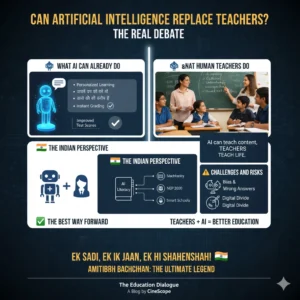Artificial Intelligence (AI) is growing fast — from chatbots to smart tutors, it’s everywhere. In education, AI is already helping students learn faster and teachers work smarter. But one question keeps coming up:
Can artificial intelligence replace teachers?
This question matters deeply, especially for India; a country with 1.4 billion people and millions of students still depending on classroom learning. Let’s look at both sides of this debate and find the real answer.

What AI Can Already Do in Education
AI has moved from being a futuristic idea to a real classroom assistant. Today’s AI tools can:
-
Create personalised learning plans for each student.
-
Mark multiple-choice tests and assignments instantly.
-
Translate content into Indian languages.
-
Give students step-by-step explanations on tough subjects.
-
Generate lesson plans and worksheets in seconds.
Platforms like Google’s AI Classroom Tools, Khan Academy’s Khanmigo, and ChatGPT are already showing how much AI can simplify teaching.
According to a UNESCO 2024 report, AI can boost efficiency and improve learning outcomes when used responsibly.
However, that doesn’t mean AI can replace human teachers. It can only assist, not lead.
What Human Teachers Do That AI Cannot
A teacher’s job goes far beyond giving information. They guide, inspire, and shape young minds. Here’s what only humans can do:
-
Emotional Connection:
Teachers sense when a student feels sad, confused, or anxious — and motivate them with empathy. AI lacks real emotions. -
Cultural Understanding:
Indian classrooms are full of diversity — languages, traditions, backgrounds. A teacher knows when to use a Hindi example, a cricket analogy, or a moral story to make learning relatable. -
Ethics and Discipline:
A machine cannot teach kindness, honesty, or teamwork. Teachers build character, not just knowledge. -
Guidance and Mentorship:
Students often look up to teachers for career advice and life lessons — something AI simply cannot replace.
In short, AI can teach content, but teachers teach life.
Studies Say: AI Helps, But Needs Humans
Global research supports a balanced approach.
A ScienceDirect study (2024) found that AI tutoring systems improve test scores in specific subjects like math or coding. But skills like communication, creativity, and critical thinking still need human interaction.
A UNESCO policy brief (2023) also stated that AI should support teachers, not replace them, especially in developing nations like India where personal guidance remains essential.
So, AI performs best when it works alongside teachers — not instead of them.

The Indian Perspective
In India, the government is already embracing AI through education reforms:
-
NEP 2020 encourages digital learning and AI literacy in schools.
-
CBSE has introduced AI as a subject from class 8 onwards.
-
IITs and NCERT are creating AI-based tools to support teachers.
These steps show that India’s goal is not to remove teachers but to empower them with technology.
Still, challenges remain — especially in rural areas where internet and digital tools are limited. That’s why training teachers and building digital infrastructure are as important as adopting AI itself.
Challenges and Risks of Using AI in Classrooms
AI can make mistakes and create new challenges if not used carefully. Some of the key risks include:
-
Bias and wrong answers: AI may give incorrect or culturally biased responses.
-
Privacy concerns: Student data must be protected under proper digital laws.
-
Digital divide: Many rural schools still lack basic connectivity and computers.
-
Teacher deskilling: Over-reliance on AI might reduce creative lesson planning.
To overcome these, schools must follow strict guidelines and give teachers training on AI literacy — knowing what AI can and cannot do.
The Best Way Forward — “Teachers + AI”
The most realistic and balanced approach is collaboration.
Here’s how it can work:
-
AI handles repetitive tasks — grading, attendance, basic doubt-solving.
-
Teachers focus on creativity, emotional learning, and guidance.
-
Students benefit from both — quick answers from AI and moral values from teachers.
This model not only improves learning outcomes but also reduces stress on teachers. AI becomes a helpful co-teacher, not a competitor.
Final Verdict
So, can artificial intelligence replace teachers?
The honest answer is No — at least not completely. AI is a powerful assistant that can make education more efficient, inclusive, and engaging. But it cannot replace the warmth, empathy, and understanding of a human teacher.
Education is not just about knowledge — it’s about values, emotions, and relationships, and those can never be programmed.
The future of learning lies in “Teachers + Technology = Better Education.”